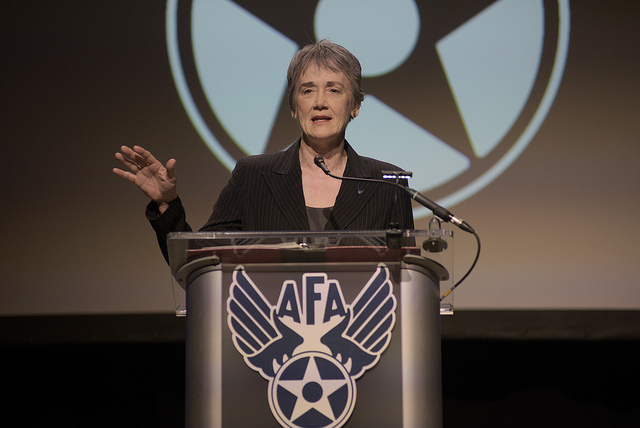
Air Force Secretary Heather Wilson provides a keynote address at AFA’s Air Warfare Symposium in Orlando, Fla., on Feb. 28, 2019. Staff photo by Mike Tsukamoto.
If the Air Force expects to execute the National Defense Strategy, it must restore readiness, which is “first and foremost about people,” Air Force Secretary Heather Wilson said in her keynote address at AFA’s Air Warfare Symposium in Orlando, Fla.
In the last two years, Wilson said the service has added nearly 9,000 airmen to its endstrength, and “we’re putting them in the squadrons that need them the most,” mostly in maintenance, cyber, and logistics. Through this effort, the Air Force has closed its maintainer gap, which was once short about 4,000 Active Duty maintainers, and is now turning its attention toward the new experience gap with these new airmen.
“In 2016, the Wisconsin Air National Guard, located at Truax Field, had only a quarter of their authorized Active Duty maintainers. The shortage meant our F-16 pilots weren’t getting flying time to train. When the jets were broke there weren’t enough maintainers to fix them,” Wilson said. “Today, the squadron is 103 percent manned with Active Duty maintainers, allowing for the development and the seasoning of our pilots to allow them to fight.”
Though the service has made significant strides with its maintainer force, it’s still working to address the pilot shortage. In her keynote, Wilson said USAF brought in 1,200 new pilots last year—146 more than expected. Still, Lt. Gen. Brian Kelly, USAF’s personnel chief, told lawmakers on Wednesday the Air Force ended fiscal 2018 with a Total Force shortage of 1,937 pilots.
Wilson also said the US is losing its technological advantage, noting for the first time in 30 years Russia “has resumed fighter patrols over the North Pole and built a ring of anti-aircraft missiles from Syria to the Eastern Arctic Circle, threatening US airpower.”
In response to rising military concerns about Russian and Chinese aggression, Wilson said more than 90 percent of “pacing squadrons,” or those needed for combat with those countries, are ready to fight. The Air Force has not specified which squadrons are part of those force packages.
Citing the need to prepare for potential conflict with other major countries, Wilson reviewed the steps the service is taking to overhaul acquisition and embrace the digital age. Her case for change also comes as the service is eyeing a major reorganization to add a new Space Force.
“We face a new era of warfare … with hypersonic weapons, offensive space capabilities, artificial intelligence, directed-energy weapons, electronic warfare, and robotics,” she said in prepared remarks. “We’ve been here before, … and airmen rose to the occasion.”
The service must improve in five areas, Wilson said:
- Constant situational awareness around the globe
- Resilient information sharing
- Fast decision-making
- Complex, unpredictable, and powerful combat systems
- Growing the ways the US can quickly disrupt its adversaries.
She pointed to several prototyping efforts and new acquisition strategies underway, including two new software programs for maintenance that automatically track the health of a fleet as well as manage flight and sustainment schedules. Those should be available next month, Wilson said.
The service’s success with the “Kessel Run” software-coding initiative is spurring another team, dubbed “Mad Hatter,” that will attempt to fix the F-35’s logistics system.
“Maintainers said they were wasting 10-15 hours a week fighting with it … and looking for ways to bypass it to try to make F-35s mission-capable,” Wilson said in prepared remarks.
The Secretary also hinted that her study of the future science-and-technology enterprise is coming soon, but stayed mum on its findings. The study, launched in 2017, aims to redefine the Air Force’s research and development priorities for the coming decades. But last year, Wilson said she was unhappy with its results and told the team to reconsider.
“Part of it was getting people to know that it was OK to think differently, … getting enough people involved to make people comfortable, not saying, ‘All right, what does the Secretary want for an answer?’” she told reporters at a Thursday morning roundtable. “We need to think differently in a domain and in a circumstance that is quite different than facing a violent extremist organization. … We’re in a different era and we probably need to prioritize and manage our research and development differently.”
Asked whether the updated study will show a need to invest in technologies the service may not have considered before, Wilson said: “Stay tuned.”

